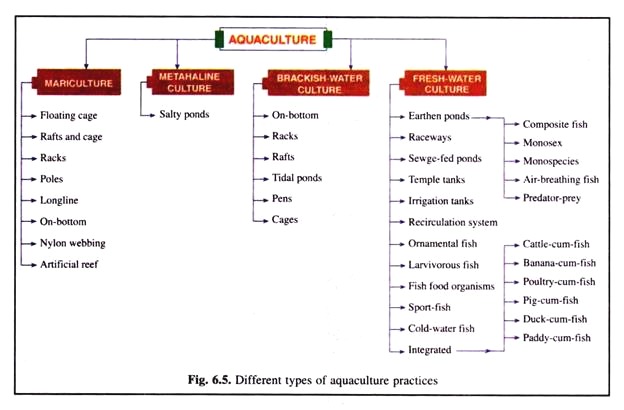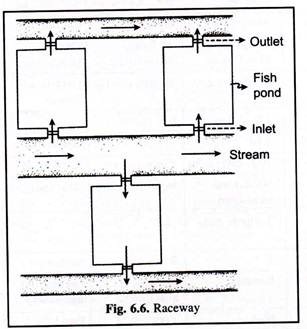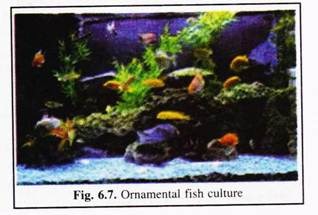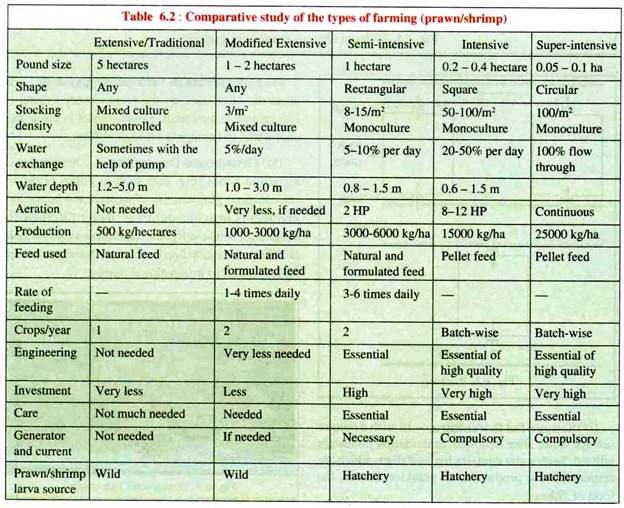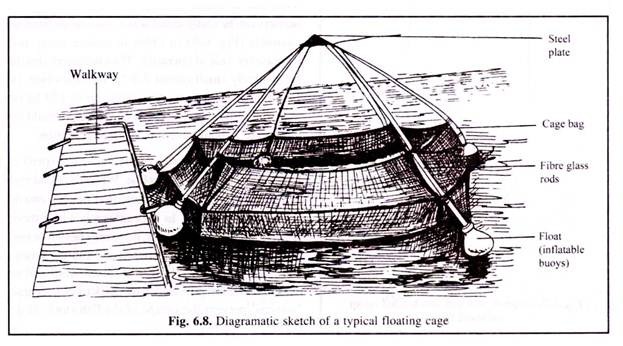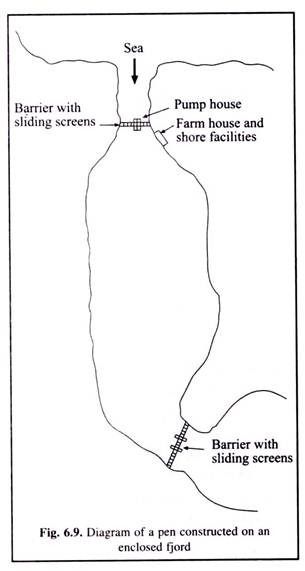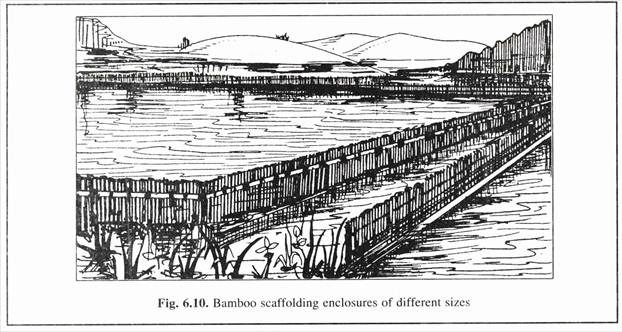In this article we will discuss about Aquaculture:- 1. Definition of Aquaculture 2. Characters of Aquaculture 3. Types of Aquaculture Practices 4. Qualities of Culturable Aquatic Species.
Definition of Aquaculture:
Fish production was previously heavily dependent upon capture fishery and in particular the marine resources. However, the capture fishery cannot be expected to be a perennial protein donar. Moreover, a substantial portion of the marine catch is being utilised for making industrial products which are not directly consumed by man.
Therefore, a viable alternative by which fish production could be increased through a popularized biotechnique, called aquaculture. Aquaculture may be defined as the “farming and husbandary of economically important aquatic animals and plants under controlled conditions”.
The term ‘aquaculture’, though over a decade has been widely used, still has a misconception by many users.
ADVERTISEMENTS:
Aquaculture is sufficiently expressive and multifaceted. It includes the following aspects:
(1) The type of organism cultured. For example, the culture of fish, prawn, oyster, mussel, seaweed, etc.
(2) The type of culture technique, such as pond culture, raceway culture, cage culture, pen culture, raft culture, etc.
(3) The aquatic environment in which the culture is done such as freshwater, brackish water or salt water.
ADVERTISEMENTS:
(4) A specific factor of the environment used for culture, such as cold water or warm water aquaculture.
Although aquaculture is considered to be a branch of fisheries science, still there is a tendency to denote the distinction between the two because of some of the basic differences in development and management.
Salient Characters of Aquaculture:
(1) High Productivity:
In comparison to agriculture or veterinary practices, aquaculture has been found to be more productive.
ADVERTISEMENTS:
(2) Integrated Farming:
Aquaculture with agriculture, horticulture or animal husbandary is found to be more profitable,
(3) Recycling:
Aquaculture gives efficient means of recycling domestic and/or agriculture wastes and thus, helps in protecting our environment.
(4) Rural Development:
Aquaculture helps to integrate rural development by generating employment opportunities and would thus help to arrest the exodus of population from rural to urban areas.
(5) Intensive Fish Culture:
In aquaculture practice, owing to the fishes three-dimensional utilization of the water body can be crowded more closely (200/ m3) and grown through water recirculation system. This gives high yield of about 25 t/ha/year.
(6) Earning Foreign Exchange:
ADVERTISEMENTS:
Commercially important items, such as ornamental fishes, Artemia cysts, prawns, lobsters, crabs, frog legs, etc., produced through aquaculture are highly valued and can earn good foreign exchange.
(7) Ranching:
Fish seeds and larvae of economically important fishes of capture fisheries are artificially recruited in fish hatcheries through aquaculture, called ranching or aquarange farming. It is commonly known as “culture based capture fishery” and involves restocking of the wild stock for harvesting. This process has replenished the dwindling stock of rivers and seas.
(8) Replenishment of Coral Reefs:
Coral reefs that have been destroyed naturally or anthropogenically are being replenished through construction of artificial coral reef.
(9) Creating Leasure-Time Activities:
Leasure- time activities can be maintained through sport fishing and creating home and public aquaria.
(10) Mariculture and Fisheries Enhancement:
In many reef areas the use of mariculture is fast growing. It provides an alternative source of income and employment in coastal areas. Replenishment schemes of species that has been greatly diminished has been undertaken in certain areas. This has been useful for returning species such as giant clams and trochus to reefs where they have been largely or completely exterminated by overfishing.
(11) Promoting Agro-Industrial Development:
Aquaculture can promote agro-industrial development through:
(i) Processing and marketing of fishery products, feeds and equipments for aquaculture,
(ii) Seaweed culture for the production of marine celluloids, and
(iii) Pearl oyster culture, etc.
Types of Aquaculture Practices:
I. Depending on Hydrobiological Features:
Depending on hydrobiological features (particularly salinity) aquaculture is divided into following:
(a) Freshwater,
(b) Brackish water,
(c) Metahaline, and
(d) Mariculture.
Various types of culture practices are carried out in each of these divisions (Fig. 6.5).
(a) Freshwater Aquaculture:
Freshwater aquaculture includes culture of various economically important aquatic organisms in small impoundments.
They are as follows:
(i) Composite fish culture or polyculture or mixed fish farming:
Fast growing compatible species of fishes with different feeding habits are cultured together.
(ii) Monosex Culture:
In this culture, separate sexes of individual species are cultured. By this method the yield can be enhanced.
(iii) Monospecies Culture:
This is concerned with the culturing of individual species of fish.
(iv) Jeol Fish Culture:
Shallow water bodies with poor oxygen content is used for culturing air breathing fish species such as Channa, Clarias, Heteropneustes, etc.
(v) Predator-Prey Culture:
Predator-prey (murrel-tilapia) culture is also undertaken in shallow waters and in swampy areas. Here, predator fish like murrels are cultured along with their prey-fish, tilapia.
(vi) Culture of Fishes in Temple Tanks:
The quality of the water in the unutilised temple tanks are poor owing to stagnation. Such tanks can be utilised for the culture of fishes such as common carp, murrel, tilapia, catfishes, etc.
(vii) Culture of Fishes in Irrigation Tank:
Irrigation tanks are fitted with inlet and outlet water sources, which can be profitably utilised for culture of Indian major carps and exotic carps.
(viii) Raceway Culture:
Raceways are series of rectangular or circular earthen or cemented tanks which is constructed in such a way that a running water system like that of a stream is maintained (Fig. 6.6).
In such culture sewage water after treatment in oxidation ponds are utilised. Such water contains high nutrients which are responsible for production of plankton bloom, the food of fishes.
(x) Fish Culture in Recirculating System:
In areas of water scarcity, the recirculatory system of fish culture is practised. Hence, water is circulated continuously through a biological filter.
(xi) Ornamental Fish Culture:
Ornamental or aquarium fishes (Fig. 6.7) such as guppy (Lebistes reticulatus), gourami (Trichogaster trichopterus), goldfish (Carassius auratus), molly (Mollienisia latipinna), siamese fighter (Betta splendeus), sword tail (Xiphophorus helleri), etc. are cultured due to their high demand in international market.
(xii) Culture of Larvivorous Fishes:
Larvivorous fishes such as Oryzias melastigma, Aplocheilus blochii and Gambusia sp. are cultured. These fishes help to control the vectors (mosquito, etc.) and can save the human population from many diseases.
(xiii) Integrated Fish Farming:
Here along with the culture of fishes, agricultural crops (rice, banana, etc.) or livestocks (pig, poultry, duck, cattle, etc.) are cultured so as to get more return.
(xiv) Culture of Sport Fishes:
Cold water fishes such as trout, salmon, etc. are cultured due to their sport value in places of high altitude like Himachal Pradesh, Kashmir, Kodaikanal, etc.
(xv) Culture of Plankton and Other Fish Food Organisms:
Mass culture of protein-rich live fish food organisms such as plankton (cladocerans, rotifers, copepods, etc.) and tubifex worms, is being done as they are essential for growing larvae of fin fish and shellfish in culture systems.
(b) Brackish Water Aquaculture:
Brackish water areas are rich in oxygen and plankton. Brackish water organisms such as milkfish (Chanos chanos), Lates calcarifer, Mugil sp. prawns, mussels, etc. can be cultured in various ways such as in tidal ponds, pens, cages or by rack, raft or rope culture (mainly in case of oysters). Mangrove crab, Scylla serrata, are also cultured in the shallow brackish water regions by constructing bamboo cages.
(c) Mariculture:
India has a long coastal and open sea area, which offers wide scope for culture operations of fin fishes and shellfishes. For the culture of fish, prawns and lobsters floating cages are used. Racks, rafts, rope, pole and long lines are used for culture of mussels, particularly pearl oysters.
Sea-weeds also are widely cultured with the help of nets or webbings.
(d) Metahaline Culture:
In off seasons of salt manufacture, the salt pans are utilised for fish culture. Culture of brine shrimp (Artemia salina) can be undertaken in these supersaline salt pan (salinity more than 200%) area. The nauplii of Artemia serve as a protein-rich live food for the fin fishes and shellfishes. The dormant eggs (cysts) of Artemia formed under unfavourable conditions also can earn good foreign exchange.
II. Depending on Motive of Farming:
Depending upon the motive of farming, based on economic and commercial considerations, fish culture practices may be classified as under:
(i) Extensive Fish Culture:
Large ponds, beels, etc. are brought under this culture (Table 6.2) where little care is taken with regard to its improvement. So it is the least managed fish farming. Here, the yield is modest and the expenditure is less as it is raised on natural food.
(ii) Intensive Fish Culture:
In this fish culture (Table 6.2) an all-out attempt is made to achieve maximum production of fish from a minimum quantity of water. It is the best managed form of fish farming and the fishes are fed on artificial food in addition to the natural feed. Here the yield is very high (over 6000 kg/ha/year). Although the cost of investment is high, the earnings from this culture far exceed the cost, so as to ensure high profit.
(iii) Semi-Intensive Fish Culture:
Intensive culture possesses certain hazards, for which a culture between the first two, called semi-intensive culture (Table 6.2), is generally practised. Here certain amount of management is required and the net profit is in between the above two.
III. Depending on Special Operational Techniques:
Based on special operational techniques, fish culture practices may be classified as below:
(i) Cage Culture:
In this culture the fishes are held in a section of water, either in a flowing river or in a big impoundment. The fishes are imprisoned in a cage made of galvanised steel wire frames with nylon meshes or simply of bamboo frames with split bamboo mats. The cages are of various sizes and the commonly used size is about 10 sq. metres.
Cages are of the following types:
(a) Floating cages (Fig. 6.8),
(b) Fixed cages,
(c) Submerged cages and
(d) Moveable cages.
The principal aim of culturing fishes in cages is to practice monoculture of selected species. Cage culture was first started in Cambodia. Since 1980 cage culture has been in practice in India.
Cage culture has proved a boon for reclaiming extensive waste waters, i.e., swamps and derelict waters of Assam, Bihar and Karnataka. Air breathing fishes (Clarias, Heteropneustes, Anabas, Channa, etc.) have responded well to cage-culture practices.
The advantages are:
1. Minimum use of all available water resources.
2. Economic use of water.
3. Easy observation and handling of the fish population on daily basis.
4. It reduces fish mortality.
5. Easiness in the control of competitors, predators and parasites.
6. Easy and complete harvesting of fishes possible.
7. Control of diseases and isolation of the diseased fishes is easy in floating cages.
8. Initial investment is relatively less.
However, there are certain limitations:
1. Risk of theft is high.
2. Adequate renewal of water in the cages for eliminating metabolites is not possible.
3. There is a need for maintenance of high dissolved oxygen content.
4. Fouling agents like snails, etc. accumulate at the bottom of the cage (mesh) which needs periodic removal.
5. The release of uneaten food and faeces adversely affect the water quality.
(ii) Pen Culture:
Pens generally refer to small enclosures used for confinement or safe keeping of domestic animals. In fisheries pens are formed by damming a bay, cove, fjord (an arm of a sea), estuary, river, lake or reservoir. Sites are selected where the barriers can be constructed across narrow sections or channels (Fig. 6.9) in order to reduce costs and increase the ease of operation.
The enclosures should be relatively small (about 2.0-7.0 ha). However, in Japan large enclosures measuring up to 120 ha or more are also seen. The depth of the pens should be more than 1 metre, even in low tide condition.
Most of the perimeter of the enclosure (pen) is formed by the natural shoreline. When the blind end of a water area is enclosed, there may be only one or one series of barriers. In the enclosures where there are continuous flows of water, there may be two or two series of barriers: one upstream and another downstream.
The barriers are made of stones, sand, soil or concrete and are provided with ‘SCREENS’. These ‘screens’ prevent the escape of the fish stock (Fig. 6.10).
The types of enclosures generally seen are:
(a) Bamboo scaffolding enclosures used in the bays of Philippines and in the lakes of China (Fig. 6.10).
(b) Floating net-enclosures useful for the culture of tilapia and milkfish in lakes.
(c) Single-layered pens of nylon webbing.
(d) Double-layered pens suitable for use as nurseries for fish and prawn seeds.
The introductions of pen culture in many countries have not met with much success. This probably is due to the difficulties in the use of intensive techniques and in some cases due to the high costs of embankments and water management (for example, through pumping).
The merits of pen culture are:
(1) As it is a continuous process due to continuous supply of water, production (yield) is greater in a limited space with rich food and oxygen supply.
(2) Higher growth rate is possible as energy is saved towards locomotion, feeding, etc.
(3) It generally generates employment opportunities for the coastal people.
(4) There is less danger of fish mortality as toxic metabolites (ammonia, etc.) are flushed regularly.
The demerits of this culture are:
(1) Unfavourable weather conditions may damage the pen or flood the culture sites.
(2) Pen culture sites may be polluted particularly during the occasional abundance of red tide causing organisms, such as ‘Dinoflagellates’.
(3) Organisms like Balanus and certain algae (Enteromorpha, etc.) may adhere to the bamboo poles causing biofouling.
(4) Terrestrial insects sometimes take refuge in the exposed portions of pens and cause damage.
(5) The nylon-webbing enclosures may be cut and damaged by certain species of crabs.
(6) Predatory fishes sometimes may enter into the pen and cause considerable damage to seed and growing fishes or prawns.
(7) Abundance of sea weeds in the outskirts of the pen, may bring down the oxygen level through release of hydrogen sulphide on death and decay.
Qualities of Culturable Aquatic Species:
In India about 465 cultivatable aquatic organisms, belonging to 107 families of animals and 28 families of plants were catalogued by Jhingran and Gopala- krishnan (1974).
All these aquatic organisms can probably be used for culture and this would be an advantage to choose from such a large number of aqua-cultured species that are adapted to different environmental conditions. This would definitely eliminate the thought of introduction of exotic species for aquaculture.
However, the main question is whether it would be worth to culture all these 465 aquatic organisms and how can all of them contribute to the main objectives of aquaculture.
Another fact is that, in such a case aquaculture would certainly miss the advantages that agriculture have had in concentrating research on a few species that had led to the development of advanced technologies of production of selected high- yielding strains and hybrids.
However, development of such technologies had required a lot of effort and time. Aquaculture science, on the other hand, is relatively new and would probably require much longer time to reach that level of advancement if efforts have to be shared among so many species.
Aquaculture till today, through long traditional experience and scientific research, have actually succeeded in domesticating only a few number of species. This, therefore, indicates that there is a tendency towards limiting the number of species in large scale commercial aquaculture.
At the same time there is a real need to have species suited for different environmental conditions and economic circumstances. Species for aquaculture, therefore, has to be selected according to the objectives of culture.
